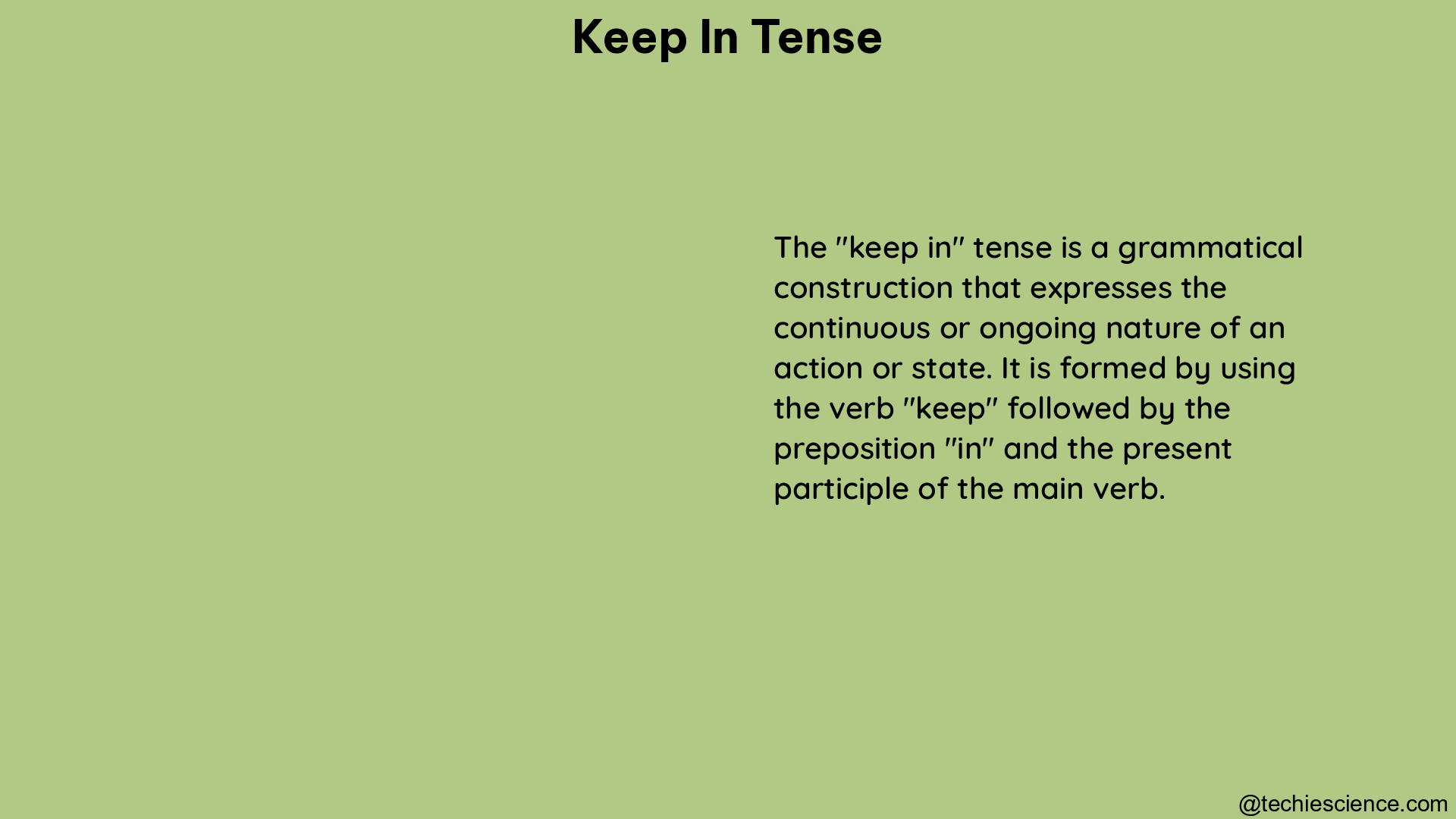The verb “keep” is a versatile and essential part of the English language, with a wide range of applications and grammatical forms. Understanding the nuances of how to use “keep” in different tenses is crucial for effective communication and writing. In this comprehensive guide, we will delve into the advanced details and grammatical specifications of “keep” in various tenses, providing you with a thorough understanding of this crucial verb.
Present Tense
In the present tense, the verb “keep” takes the following forms:
Singular:
– I keep
– You keep
– He/She/It keeps
Plural:
– We keep
– You keep
– They keep
Examples:
– I keep my room tidy.
– She keeps her promises.
– They keep the store open late.
Present Progressive Tense

The present progressive tense is used to describe an ongoing action or state. The forms of “keep” in the present progressive tense are as follows:
Singular:
– I am keeping
– You are keeping
– He/She/It is keeping
Plural:
– We are keeping
– You are keeping
– They are keeping
Examples:
– I am keeping a close eye on the situation.
– She is keeping the secret safe.
– They are keeping the tradition alive.
Past Tense
In the past tense, the verb “keep” takes the following forms:
Singular:
– I kept
– You kept
– He/She/It kept
Plural:
– We kept
– You kept
– They kept
Examples:
– I kept the promise I made.
– She kept the secret for years.
– They kept the party going all night.
Present Perfect Tense
The present perfect tense is used to describe an action that has been completed in the past but has relevance to the present. The forms of “keep” in the present perfect tense are as follows:
Singular:
– I have kept
– You have kept
– He/She/It has kept
Plural:
– We have kept
– You have kept
– They have kept
Examples:
– I have kept my word.
– She has kept the family tradition alive.
– They have kept the business running for decades.
Present Perfect Progressive Tense
The present perfect progressive tense is used to describe an ongoing action that began in the past and is still continuing. The forms of “keep” in the present perfect progressive tense are as follows:
Singular:
– I have been keeping
– You have been keeping
– He/She/It has been keeping
Plural:
– We have been keeping
– You have been keeping
– They have been keeping
Examples:
– I have been keeping a close eye on the project.
– She has been keeping the family together.
– They have been keeping the community informed.
Past Progressive Tense
The past progressive tense is used to describe an ongoing action or state in the past. The forms of “keep” in the past progressive tense are as follows:
Singular:
– I was keeping
– You were keeping
– He/She/It was keeping
Plural:
– We were keeping
– You were keeping
– They were keeping
Examples:
– I was keeping a journal during my travels.
– She was keeping the family business afloat.
– They were keeping the tradition alive.
Past Perfect Tense
The past perfect tense is used to describe an action that was completed before another past action or event. The forms of “keep” in the past perfect tense are as follows:
Singular:
– I had kept
– You had kept
– He/She/It had kept
Plural:
– We had kept
– You had kept
– They had kept
Examples:
– I had kept the secret for years before it was revealed.
– She had kept the family heirloom safe for generations.
– They had kept the business running through difficult times.
Past Perfect Progressive Tense
The past perfect progressive tense is used to describe an ongoing action that was in progress before another past action or event. The forms of “keep” in the past perfect progressive tense are as follows:
Singular:
– I had been keeping
– You had been keeping
– He/She/It had been keeping
Plural:
– We had been keeping
– You had been keeping
– They had been keeping
Examples:
– I had been keeping a close eye on the project before the deadline.
– She had been keeping the family together during a difficult time.
– They had been keeping the community informed about the changes.
Future Tense
In the future tense, the verb “keep” takes the following forms:
Singular:
– I will keep
– You will keep
– He/She/It will keep
Plural:
– We will keep
– You will keep
– They will keep
Examples:
– I will keep my promise to you.
– She will keep the family tradition alive.
– They will keep the business running smoothly.
Future Progressive Tense
The future progressive tense is used to describe an ongoing action or state in the future. The forms of “keep” in the future progressive tense are as follows:
Singular:
– I will be keeping
– You will be keeping
– He/She/It will be keeping
Plural:
– We will be keeping
– You will be keeping
– They will be keeping
Examples:
– I will be keeping a close eye on the project.
– She will be keeping the family together during the move.
– They will be keeping the community informed about the changes.
Future Perfect Tense
The future perfect tense is used to describe an action that will be completed before another future action or event. The forms of “keep” in the future perfect tense are as follows:
Singular:
– I will have kept
– You will have kept
– He/She/It will have kept
Plural:
– We will have kept
– You will have kept
– They will have kept
Examples:
– I will have kept my promise by the time you return.
– She will have kept the family tradition alive for generations.
– They will have kept the business running for decades.
Future Perfect Progressive Tense
The future perfect progressive tense is used to describe an ongoing action that will be in progress before another future action or event. The forms of “keep” in the future perfect progressive tense are as follows:
Singular:
– I will have been keeping
– You will have been keeping
– He/She/It will have been keeping
Plural:
– We will have been keeping
– You will have been keeping
– They will have been keeping
Examples:
– I will have been keeping a close eye on the project before the final presentation.
– She will have been keeping the family together during the transition.
– They will have been keeping the community informed about the changes for months.
By mastering the various forms and usages of the verb “keep” in different tenses, you can enhance your English language proficiency and communicate more effectively in a wide range of contexts.
References
- Reverso Conjugator English. (n.d.). Conjugate verb keep. Retrieved from https://conjugator.reverso.net/conjugation-english-verb-keep.html
- Simple English Wiktionary. (n.d.). kept. Retrieved from https://simple.wiktionary.org/wiki/kept
- WordHippo. (n.d.). What is the past tense of keep? Retrieved from https://www.wordhippo.com/what-is/the-past-tense-of/keep.html
- Writing English. (n.d.). Keep. Retrieved from https://www.writingenglish.com/cverbs/keep.htm
- WordReference.com. (n.d.). Conjugation of keep. Retrieved from https://www.wordreference.com/conj/enverbs.aspx?v=keep

Hi…. I am Goutam Datta. I have completed a double M. A. in English and B. Ed. I am a creative writer. Currently, I am a part of the LambdaGeeks.